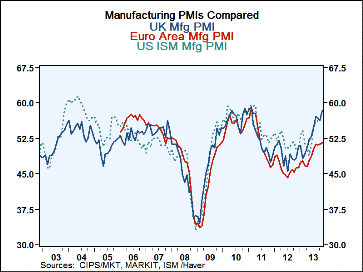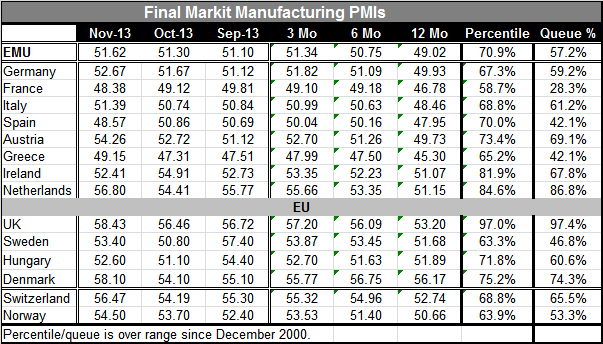 Global| Dec 02 2013
Global| Dec 02 2013Manufacturing on Slow Rise in Europe
Summary
The PMI gauges for manufacturing in Europe show a pick-up in the manufacturing sector for EMU. Manufacturing output has snaked up to a reading of 51.62 in November from 51.30 in October. Half of the eight member countries in the table [...]
 The PMI gauges for manufacturing in Europe show a pick-up in the manufacturing sector for EMU. Manufacturing output has snaked up to a reading of 51.62 in November from 51.30 in October. Half of the eight member countries in the table show manufacturing PMI improvement in November and half show declines. Germany, Italy Austria and the Netherlands show improvements in the month.
The PMI gauges for manufacturing in Europe show a pick-up in the manufacturing sector for EMU. Manufacturing output has snaked up to a reading of 51.62 in November from 51.30 in October. Half of the eight member countries in the table show manufacturing PMI improvement in November and half show declines. Germany, Italy Austria and the Netherlands show improvements in the month.
Only the Netherlands, Ireland, Austria and Italy post queue standings in their manufacturing PMI readings that are above the 60th percentile of their historic queue back to early 2001. But of these only the Netherlands and Austria have relatively strong PMI values. It is a testament to how contained MFG has been in EMU since the euro area was formed.
The six non-EMU member countries in the table are doing relatively better than the euro zone members as four of them have PMI standings at or above the 60th percentile of their respective queues back to early 2001. Only Sweden has a relatively weak queue standing, in the 46.8 percentile of its queue. However, the raw reading for Sweden is at 53.40, still above the average reading in EMU.
Looking at changes in the manufacturing indices within EMU, France and Spain are net lower over three months. For EMU as a whole, the current reading is net higher over three months but only by a thin 0.24 points. There is not only a good deal of disparity among PMI readings in the euro zone but also disparity on momentum. The strongest upward momentum over three months is from the Netherlands (+3.26) and Austria (+2.26).
Among the non-EMU countries two of six show net declines over three months: Sweden and Denmark. The strongest net gains in this group over three months are from Switzerland (+1.88) and Norway (+1.50).
The bottom line is that growth is in progress even though it is irregular. Looking back in the cycle, all EMU members are showing strong elevations of their PMIs from their respective cycle lows. Most member indices are more than twice the distance from their cycle lows as they are from their cycle highs. France and Greece are exceptions in this.
In September five of eight EMU members in the table showed declining PMIs along with a drop for the EMU overall. Just two months later in November only three members are contracting and the EMU overall is advancing. It is progress, but it is still slow, uneven and vulnerable.

Robert Brusca
AuthorMore in Author Profile »Robert A. Brusca is Chief Economist of Fact and Opinion Economics, a consulting firm he founded in Manhattan. He has been an economist on Wall Street for over 25 years. He has visited central banking and large institutional clients in over 30 countries in his career as an economist. Mr. Brusca was a Divisional Research Chief at the Federal Reserve Bank of NY (Chief of the International Financial markets Division), a Fed Watcher at Irving Trust and Chief Economist at Nikko Securities International. He is widely quoted and appears in various media. Mr. Brusca holds an MA and Ph.D. in economics from Michigan State University and a BA in Economics from the University of Michigan. His research pursues his strong interests in non aligned policy economics as well as international economics. FAO Economics’ research targets investors to assist them in making better investment decisions in stocks, bonds and in a variety of international assets. The company does not manage money and has no conflicts in giving economic advice.






